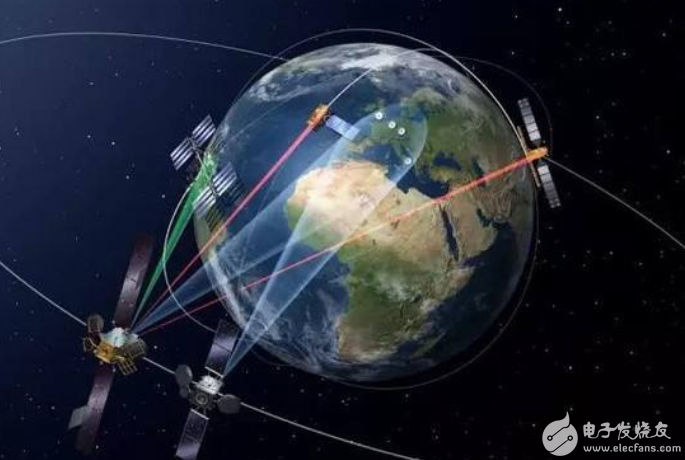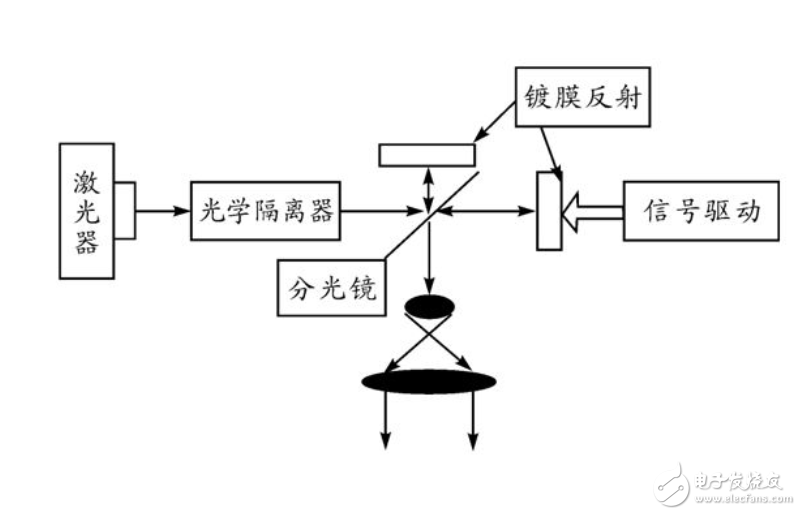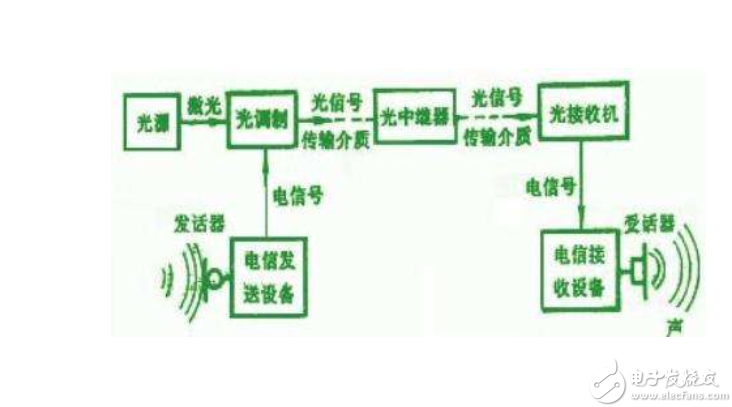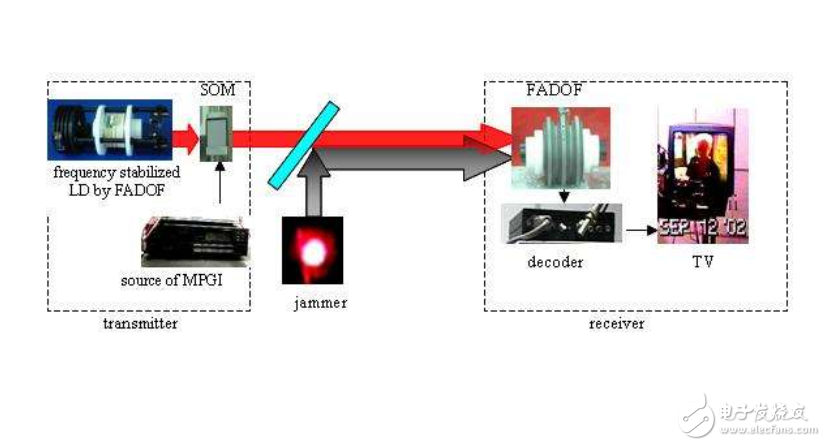Space laser communication is a communication method that uses a laser beam as a carrier to transmit information such as images, voices, signals, and the like in space. Compared with traditional microwave communication, laser communication has the advantages of fast transmission rate, large communication capacity, strong anti-electromagnetic interference performance, high confidentiality, etc., and its communication terminal is small in size, low in power consumption, and extremely practical, which has caused research booms in various countries. Today, the electronic enthusiasts Xiaobian will explain to you the past and present of space laser communication technology.

What is space laser communication technology?

Space laser communication refers to the use of a laser beam as an information carrier for space î—° including atmospheric space, low orbit, medium orbit, synchronous orbit, interstellar, and space communication.
Compared with microwave space communication, laser space communication is significantly shorter than microwave wavelength, and has high coherence and spatial orientation, which determines that space laser communication has large communication capacity, light weight, low power consumption and small volume, and high confidentiality. Low construction and maintenance costs.
1. Large communication capacity: The frequency of the laser is 3-4 orders of magnitude higher than that of the microwave (the corresponding optical frequency is 1013-1017 Hz), and the carrier for communication has a larger utilization frequency band. Optical fiber communication technology can be transplanted into space communication. At present, the data rate of each beam of optical fiber communication can reach more than 20Gb/s, and the wavelength division multiplexing technology can be used to increase the communication capacity by several times. Therefore, optical communication has a huge advantage over microwave communication in terms of communication capacity.
2. Low power consumption: The divergence angle of the laser is small, the energy is highly concentrated, the power density falling on the antenna of the receiver telescope is high, the transmission power of the transmitter can be greatly reduced, and the power consumption is relatively low. This is very suitable for space communication where energy costs are high.
3, small size, light weight: due to the high energy utilization of space laser communication, the weight of the transmitter and its power supply system is reduced; due to the short wavelength of the laser, at the same divergence angle and receiving field of view angle requirements, launch and The aperture of the receiving telescope can be reduced. Get rid of the huge dish antenna of the microwave system, reduce weight and reduce volume.
4, a high degree of confidentiality  laser has a high degree of directionality, the transmission beam is slender, the laser divergence angle is usually in milliradians, which makes laser communication with a high degree of confidentiality, can effectively improve the anti-interference, anti-eavesdrop ability.
5. Laser space communication has low construction costs and maintenance funds.
Prospect of space laser communication technology

(schematic diagram)
I. Advantages and Challenges Coexist With the development of space technology and sensing technology, the amount of information required for satellites and various spacecraft is exponentially increasing. Currently, the communication means based on microwave communication adopted by space communication has been It is difficult to meet the rapidly growing demand for communication capacity. Space laser communication has high data transmission rate, strong electromagnetic anti-interference ability and security and confidentiality. Laser communication equipment also has the advantages of small size, light weight and low energy consumption. It is considered to be the most promising space for innovation. Subversive technology.
High data transfer rate. The space frequency of space laser communication ranges from 190 THz to 560 THz, which is about several thousand times or even tens of thousands of times of the microwave communication frequency. It has a huge bandwidth lifting space, can achieve higher data transmission rate, and returns massive video and space from space. High-precision measurement data is possible, and it has important strategic significance for natural disaster monitoring and military communications.
The system terminal is small in size, light in weight, and low in power consumption. Compared to microwaves, the wavelength of the laser is thousands to tens of thousands of times shorter. The shorter the wavelength, the higher the energy, the smaller the diffraction effect, and the size of the transmitting and receiving antennas required for the laser can be doubled, making the volume, quality and power of the laser communication system terminal far superior to microwave communication. Meet the requirements of space applications for miniaturization, lightweight, and low power consumption.
Strong anti-electromagnetic interference capability and high security and confidentiality. Space laser communication uses laser as the carrier. The laser beam is extremely narrow, the divergence angle is less than 1mrad (milli radians), the brightness and energy density are extremely high, the information transmission is not easily captured by other devices, and the communication interference between adjacent satellites is negligible. High immunity to electromagnetic interference and security.
Despite the many advantages, space laser communication technology is still in the research stage as a whole, and still faces many technical challenges. For example, laser communication is subject to the influence and interference of laser communication terminals and detectors, atmospheric turbulence, atmospheric attenuation and other factors. The ground infrastructure required for laser communication is far from complete, and the technical advantages of space laser communication high-band and high-bandwidth have not been fully explored.

Second, countries have set off research booms. The United States, Europe, and Japan have invested heavily in space laser communication technology to conduct related technology research and on-orbit testing. They have conducted comprehensive and in-depth research on various key technologies involved in space laser communication systems. Constantly promote space laser communication technology to the practical use of engineering.
(I) NASA Accelerates the Development of Space Laser Communication Technology The research on projects such as the "laser communication demonstration system" (OCD) and "transition satellite communication system" (TSAT) carried out in the early days of the United States laid a good technical foundation for the later development of technology. In recent years, the National Aeronautics and Space Administration (NASA) has paid particular attention to the development of space laser communication technology as an important priority, accelerating the development and maturity of space laser communication technology, and enabling space communication for near-surface missions and deep-space missions. To be efficient, to solve the massive data transmission problems faced by future space missions.
"Lunar Laser Communication Demonstration" project. In October 2013, NASA successfully launched the Lunar Laser Communication Demonstration (LLCD) project, which conducted two-way laser communication experiments from the lunar orbit and multiple ground stations, creating a downlink data transmission rate of 622 Mbit/s. The new record, the uplink data transmission rate also reached 20 Mbit/s, which verified the feasibility of the space laser communication system and the survivability of the system in the space environment for the first time.
"Laser communication relay demonstration verification" project. The "Laser Communication Relay Demonstration and Validation" (LCRD) project being carried out by NASA in the United States is mainly used to verify the effectiveness and reliability of laser communication technology. The system includes two geosynchronous orbital spaceborne laser communication terminals and two ground laser communication terminals. NASA plans to launch a spaceborne laser communication terminal to geosynchronous orbit in 2019 to carry out a two-year laser communication relay demonstration and verification mission. In the mission, a ground station in California will transmit a laser signal to a geosynchronous orbiting laser communication terminal at a distance of approximately 36,000 kilometers, and then the geosynchronous orbital spaceborne laser communication terminal relays the signal to another ground station. At present, the NASA "Laser Communication Relay Demonstration" system has successfully passed the critical decision review and entered the development integration and testing phase.
"Deep Space Optical Communication" project. The "Deep Space Optical Communication" (DSOC) project has a farther communication distance than the "Laser Communication Relay Demonstration" project, and is dedicated to studying the improvement of laser communication for deep space mission data rate, space and power consumption. The "deep space optical communication" system laser communication device is expected to fly a NASA "Psyche" spacecraft to an asteroid composed of metal elements in 2023, and the laser communication technology will be tested.
"Integrated RF and Optical Communication" project. The NASA Glenn Research Center team is conducting an "Integrated Radio Frequency and Optical Communications" (IROC) concept study, planning to send a laser communication relay satellite to Mars orbit to receive data from remote spacecraft and relay data to Earth. The "Integrated RF and Optical Communications" system will use RF and laser integrated communication systems to serve both new spacecraft using laser communication systems and traditional spacecraft using RF communication systems, which will effectively promote NASA. Interoperability between all space assets.

(II) ESA focuses on promoting the commercialization of laser communication systems. The “Semiconductor Laser Inter-Star Link Test†(SILEX), which was implemented early in the European Space Agency (ESA), verified the low-Earth orbit (LEO) to geosynchronous orbit for the first time. (GEO)'s inter-satellite communication, the great success of the project gave ESA great confidence. At the end of 2008, ESA decided to apply laser communication terminals in its European Data Relay System (EDRS) to facilitate the development and implementation of space laser communication systems to a mature stage and operate in a business model. In recent years, the “European Data Relay System†has made a series of breakthroughs and became the world's first high-speed space laser communication system for commercial operation.
"European Data Relay System" is the world's first independently operated commercial space laser communication system jointly developed by ESA and Airbus Defense and Space Corporation under the Public-Private Partnership (PPP) mechanism. The bureau is responsible for system development, and Airbus Defence and Space Corporation is the project's main contractor responsible for the construction, launch and operation of the system. The "European Data Relay System" relays large amounts of data to the European ground stations in near real-time by using laser communication technology for geostationary orbits for low-Earth orbit satellites and airborne platforms. The spatial segment of the European Data Relay System Phase I system consists of two geostationary orbit nodes, the EDRS-A data relay payload and the EDRS-C dedicated satellite configured with the data relay payload.
The first laser communication relay load EDRS-A of the "European Data Relay System" was successfully launched on January 30, 2016, and took an important step in building the world's first satellite laser communication business operation system. EDRS-A provides two-way inter-satellite links in both laser and Ka-band, with inter-satellite transmission rates of up to 1.8 gigabits per second. After completing a series of on-orbit tests, EDRS-A successfully transmitted images of the European "Sentinel" 1A radar satellite in June 2016 and entered the operational phase in July 2016. The EDRS-A load realizes on-orbit service, indicating that Europe has taken the lead in realizing the commercial application of inter-satellite high-speed laser communication technology, which is an important milestone in the rapid development of European space technology in recent years.
ESA plans to expand into a global coverage system by 2020, forming a space-based information network with laser data relay satellites and payloads as the backbone, enabling near-real-time transmission of satellite and airborne observation data. EDRS will not only meet the growing demand for spatial data transmission rate, transmission volume and real-time performance of European space activities, but will also free Europe from dependence on non-European ground stations and maintain the strategic independence of space communications. ESA believes that the US Department of Defense and its drone fleet will be the main market for EDRS in the future.
(3) Japan is committed to miniaturization of laser communication terminals

Japan has mainly carried out research on space laser communication technology in the form of international cooperation. The early implementation of the “Ground Communication Test and Verification†(GOLD) project has achieved great success, achieving the world's first low-orbit satellite and ground station and mobile optics. Laser communication test between ground stations. In recent years, in order to maintain the advantages of space laser communication technology, Japan has begun to develop laser communication terminals in a smaller, lighter, and lower power consumption direction.
"Spatial Optical Communication Research Advanced Technology Satellite" program. Japan's "Spatial Telecommunications Research Advanced Technology Satellite" (SOCRATES) program is designed to validate "Small Optical Communication Terminals" (SOTA) for 50 kilograms of small satellites. In May 2014, the “small optical communication terminal†was launched with low-orbit small satellites, and the low-orbit satellite-to-ground laser communication test was successfully carried out between August and November 2014. The "small optical communication terminal" has a total mass of only 5.8 kilograms, a maximum communication distance of 1000 kilometers, and a downlink communication rate of 10 megabits per second. It can build an absolutely secure global optical communication network, enabling high resolution of aircraft and satellite collection. Image data can be transmitted to the ground station via a spatial laser communication link.
"Laser Data Relay Satellite" program. The new version of the "Space Data Relay Satellite" program, which was released on January 9, 2015 in Japan, officially included the "Laser Data Relay Satellite" program, and in the fiscal year 2015, it allocated 3.208 billion yen as the start-up fund. Japan plans to launch a "laser data relay satellite" in 2019, replacing the microwave link of the current data relay system with a laser link, and realizing communication between a new generation of high-resolution Earth observation satellites such as advanced optical satellites through lasers. The preset communication rate is 2.5 Gbit/s, which will give Japan a higher speed real-time observation capability.

Third, it contains great application value The high speed and high security of space laser communication will continue to meet the increasing demand of space activities for spatial data transmission rate, transmission volume and real-time, which will surely become the main form of future space communication. In-depth exploration and utilization of the huge application value of space laser communication is of great significance to enhance the real-time, security and future deep space detection of current spatial information transmission.

(1) Meeting the ever-increasing demand for communication bandwidth in informationized warfare Modern information warfare requires more and more communication bandwidth, such as battlefield remote sensing mapping information, real-time combat high-definition images, and strong interference with command interactions in complex electromagnetic environments. An exception requires a stable information transmission technology to ensure that the demand for bandwidth resources of the communication system increases dramatically. Due to the high cost and the shortage of satellite orbit resources and spectrum resources, traditional microwave satellite communication systems are difficult to meet the urgent needs of combat personnel to obtain real-time battlefield situation data. The space laser communication system has a huge bandwidth improvement space, can achieve higher data transmission rate, and can fully guarantee the real-time transmission of massive information on the battlefield. At the same time, the laser transceiver device and the signal processing device are small in size, light in weight, and low in power consumption. It is feasible to equip multiple laser transceivers on the star, which lays a foundation for the subsequent development of multi-antenna laser communication technology, thereby further increasing the data transmission rate. Ensure the timely transmission of battlefield information.
(II) Ensuring the security and stability of battlefield data transmission The security and stability of battlefield data transmission is essential to ensure the full access of the operational unit's information advantages and the full play of operational effectiveness. Due to the openness of spectrum planning and the problem of signal sidelobe leakage, the traditional microwave communication technology makes it easy for the enemy to analyze and crack the signal through the signal detection device, resulting in security risks. At the same time, the mature high-power broadband electromagnetic pulse technology will also cause the traditional satellite communication technology to be interfered on the battlefield and lose the battlefield information right. Space laser communication has high security features, is difficult to be stolen and interfered, completely avoids the shortcomings of traditional microwave communication technology, its extremely strong directional beam makes the signal leakage almost negligible, and the high frequency of laser communication High bandwidth will also invalidate traditional interference suppression methods.
(III) Achieving near-Earth missions and deep-space missions Efficient space communication Laser communication technology is expected to increase data transmission rate by at least 10 to 100 times than RF communication, and can greatly increase data transmission rate in all spatial regions from low Earth orbit to interstellar To make space communication between near-surface missions and deep-space missions more efficient. Higher data rates mean that live video can be transmitted from anywhere in the solar system in the future, and the communication bandwidth of manned deep space exploration missions can be increased, helping researchers to collect scientific data faster, study dust storms or spacecraft landings, etc. Incidents, even sending video from other planet surfaces. It is conceivable that once the space laser communication network is established, humans will open a fast and reliable data connection network to the moon, and even connect to Mars and more distant planets, providing important communication support for humans to conquer distant stars.
Summary: The development and breakthrough of space laser communication technology is of great significance for enhancing the real-time, security and future deep space detection of spatial information transmission, and it is expected to change the future development of space communication technology.
In fact, what people usually call a pinhole camera does not use a pinhole lens. Pinhole lens refers to a lens that uses the principle of small hole imaging to obtain images. It is inexpensive and simple in principle, but its fatal weakness is that too little light passes through the small hole, resulting in too long exposure time. Taking photos with a pinhole lens in sunlight can take anywhere from a few minutes to a dozen minutes, especially when shooting at night with exposure times of up to several hours. Obviously, for a camera that shoots dozens to dozens of frames per second, it cannot meet the requirements. Pinhole lenses cannot be applied to cameras, so there is no "pinhole" camera in the strict sense. As is customary, a miniature camera using a fisheye lens, a flat lens or a conical lens is called a pinhole camera.
According to the lens, the lens of the pinhole camera can be divided into three types: fisheye lens, flat lens and conical lens; according to the photosensitive element used, it can be divided into charge coupled element and complementary metal oxide semiconductor; According to the data transmission method, it can be divided into two categories: wireless cameras and wired cameras.
Pinhole Hidden Camera,4k,High capacity battery
Jingjiang Gisen Technology Co.,Ltd , https://www.gisengroup.com